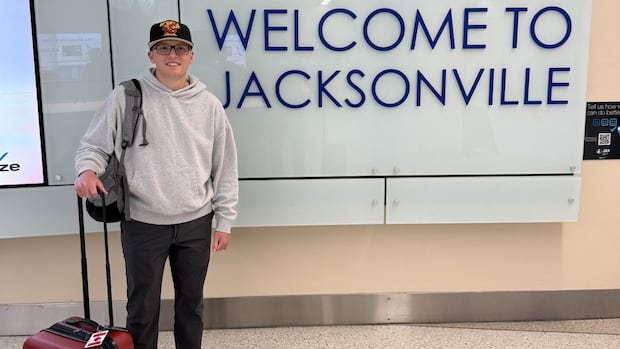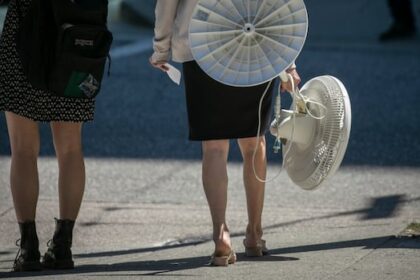Hundreds of Ontario patients have been sent to U.S. hospitals and clinics for government-reimbursed medical care since 2018, according to exclusive data obtained by CBC News.The costs — over $212 million — were covered by taxpayers money through OHIP, the province’s publicly funded health-care plan.Among the approved applications for out-of-country care are radiation treatments for children in Florida, inpatient treatment for eating disorders in Wisconsin, genomic cancer therapy in New York, Massachusetts and Ohio, and consultations for gender-affirming surgeries in California.The long-standing program, which has equivalents in every province, is for patients who need treatments or surgeries that aren’t available in Canada, or who could die if care is delayed.While most physicians and health economists interviewed by CBC agree the practice is cost-effective and life-saving, some say it also highlights gaps that could be better filled through cooperation among provinces — rather than relying on the U.S. private health-care system.”We tend to look south as opposed to looking east and west, and if the provinces knew what each other were doing, then we might be able to cooperate more than we do,” said Prof. Arthur Sweetman, co-director of the Centre for Health Economics and Policy Analysis at McMaster University in Hamilton, commenting on CBC’s data analysis.Ontario does not openly provide the public with details of its out-of-country care program, such as which specific surgeries or treatments are paid for, how much they cost, and where patients are sent.CBC News had to file several freedom of information requests — beginning in 2023 — to obtain data related to over 3,100 applications submitted to Ontario’s Out-of-Country Prior Approval Program between 2018 and 2024, including hundreds which were ultimately denied.The data obtained represents the number of applications submitted for consultations, tests, surgeries and follow-up visits in foreign facilities, not the number of patients. One person may be tied to several requests over time, for example, an initial consultation, subsequent imaging and an eventual surgery. Here’s what CBC found in Ontario’s out-of-country care data: On average, roughly half (54 per cent) of all requests for out-of-country care were approved every year between 2018 and 2024. The main reason given to approve the majority of requests (80 per cent) was that the treatment “was not performed in Ontario” and there was no identical or equivalent procedure. The remaining requests (20 per cent) were approved despite a treatment existing in the province because “a delay would result in death or medically significant irreversible tissue damage.” The vast majority of approved requests (95 per cent) are for treatments and surgeries in U.S. clinics and hospitals — mostly in the states of New York, California and Michigan. Requests also name facilities in Thailand, Italy, Belgium, Serbia and other countries. The most expensive procedure in 2024 was proton beam therapy, costing the province $2.4 million in medical bills for 29 approved requests. Requests for complex gender-affirming surgeries — mostly phalloplasty and vaginoplasty procedures — rose to 139 in 2024, a significant increase from the average of 41 requests seen in prior years (2018-2023). Family finds trips abroad disruptive and stressfulLuke Serfas is among hundreds of Canadian patients who had to travel abroad for care this year.Last March, the 16-year-old from Turin, Alta., near Lethbridge, learned the headaches his family chalked up to a bad concussion during a hockey game were actually the side effects of a brain tumour.”They called us and said, no, this is a cancerous brain tumour,” said Serfas. “You need to go up to the [Alberta] Children’s Hospital, and there’s a room ready. Me and my mom, we were sitting in Lethbridge Emerg just crying.”The next shock for his father, Mark Serfas, was finding out his son would have to spend six to eight weeks in Jacksonville, Fla., to get the proton beam therapy he understood to be most beneficial for his condition, because the treatment isn’t available anywhere in Canada.Luke Serfas, centre left, poses with his family outside the UF Health Proton Therapy Institute in Jacksonville, Fla. The Alberta government paid for his treatment, an alternative to X-ray radiation, this summer because it is not available anywhere in Canada. (Amy Serfas)Unlike other radiation treatments, proton beam therapy can deposit energy up to a specific depth, thereby reducing the exposure to the healthy brain tissue surrounding the tumour. The treatment is intended to minimize long-term effects on a child’s cognitive skills, according to experts.”The financial aspect is one thing, but the emotional … to go there and seclude yourself and figure this all out, it adds a whole bunch of stress that families going through this don’t have to have,” said Mark, before leaving for Florida.He says he’s grateful Alberta’s out-of-country care program will pay for the U.S. hospital bills and some of the travelling costs, but he worries about Luke being so far away from home for weeks at a time.”Whether that be in one year or two years or three years or five years, but I would really hope that this kind of treatment can be offered a little bit closer to home.”In a statement to CBC News, the Alberta government said it covers insured physician and hospital services for out-of-country care, and may also cover flights. However, funding does not cover other expenses such as meals, hotels, or car rentals.Canada only G7 country without proton beam treatmentIn Ontario, proton beam therapy has been the single biggest expenditure of the Out-of-Country Prior Approval Program every year since 2022.CBC’s analysis found the majority of patients are sent to the University of Florida Proton Therapy Institute in Jacksonville, the same hospital where Luke Serfas was referred for treatment.CBC spoke with multiple radiation oncologists across the country who regularly refer children and teens to the U.S. for the newer treatment. Several pointed out that Canada is now the only G7 country without a clinical proton beam therapy facility.”The data I’ve seen suggests there’s enough volume to justify having at least one machine in Canada, probably two,” said Dr. Glen Bauman.Dr. Glenn Bauman is a radiation oncologist at Victoria Hospital in London, Ont. Bauman sends most of his young brain tumour patients to Florida and also helps the province review applications to its Out-of-Country Prior Approval Program. (Turgut Yeter/CBC)The radiation oncologist at Victoria Hospital in London, Ont., is on the panel of experts who reviews applications for out-of-country care for the province.He says he probably sees a case related to proton beam therapy “every other week.”The biggest challenge to offering the treatment here is its price tag, said Bauman.”These are expensive machines. They need a lot of people to keep them up, physicists, engineers. They’re just very expensive equipment to maintain,” he said.Out-of-country requests hint at bigger demand, says expertWhen considering whether to invest in costly equipment, the question becomes how many more patients could benefit if they didn’t have to travel abroad.Aaron Jones, an assistant professor in the Department of Health Research Methods, Evidence and Impact at McMaster University, says there’s almost certainly more demand for a given treatment than the data on foreign treatment applications show.”There’s probably more people who, if that service were available, would do it here, but because it’s a big upheaval, it’s expensive to travel outside the country, they might not be taking advantage of that,” said Jones.”I’m sure we’ve been under-referring,” said radiation oncologist Bauman after seeing CBC’s findings. He explained that proton beam therapy is also beneficial for specific tumours in adults.”Probably between 10 and 20 per cent of all radiation treatments there might be some benefit to think about protons if we had that available. We’re talking a few thousand [patients] a year.”Gaps in specialized expertise highlighted by dataShould Ontario spend abroad or invest at home? It all comes down to an economy of scale.Despite the inconvenience for patients, using other countries’ multimillion-dollar machines and relying on foreign expertise for highly specialized surgeries can make financial sense, said the three health economists CBC shared its findings with.”It might be better to send people to one place in the world that really specializes in something so that the patients can receive really high quality care rather than having someone in Ontario do something that they do very infrequently,” said Sweetman.”It’s the reason why every city doesn’t have its own children’s hospital.”Arthur Sweetman is a professor of economics at McMaster University in Hamilton, and the Ontario Research Chair in Health Human Resources. (Oliver Walters/CBC News)One example of that is gender-affirming surgeries such as phalloplasty and vaginoplasty, said Dr. David Urbach, head of the surgery department at Women’s College Hospital in Toronto.According to Urbach, Women’s College remains the only publicly funded clinic in Ontario offering vaginoplasties and now performs close to 100 of these procedures a year.Urbach adds that both procedures are considered highly specialized and complex surgeries and only a handful of surgeons perform phalloplasties in Canada, none of them available in Ontario’s public system.”The problem in particular with phalloplasty is that the numbers of procedures tend to be much smaller,” said Urbach. “Whenever we’re dealing with a procedure that’s done rarely, then we have to think about our ability to be able to provide that safely with appropriate expertise.”‘Someone is paying attention’All three health economists who examined CBC’s findings mentioned that while the cost to taxpayers for Ontario’s program might seem excessive — anywhere from $20 million to $50 million a year — it actually represents less than one per cent of total health-care expenditures.They also noted that the program’s expenses dropped by more than 60 per cent between 2018 and 2023, largely due to chimeric antigen receptor (CAR) T-cell therapy becoming available in Ontario hospitals.The genomic cancer therapy — used for pediatric leukemia and adult lymphoma — was the single biggest expenditure under the program until 2021, costing just over $66 million for 116 treatments, most of them at two cancer centres in Buffalo, N.Y., and Philadelphia.At the time, that treatment abroad cost taxpayers over half a million dollars in medical and travel bills per approved request.”Someone’s paying attention, there’s a natural evolution. As demand increases, as need increases, Ontario responds,” said Sweetman, the McMaster professor.Alberta looking for guidance on proton therapyThis month, the government of Alberta posted an online information request for insight from industry stakeholders to inform potential future planning of proton beam therapy services in the province, with a deadline of Oct. 1.”We are exploring what it would take to establish these services within the province and how we can ensure access not only for Albertans but potentially for patients across Canada,” wrote the Ministry of Hospital and Surgical Health Services in a statement to CBC News.Meanwhile in Ontario, the province pledged up to $5 million in 2022 to “plan for Canada’s first hospital-based proton beam therapy facility,” calling it an “innovative lifesaving cancer treatment.”CBC News asked the Ministry of Health when the facility is expected to be up and running.A spokesperson replied by email, “We are working with the Proton Therapy Planning Group … on further future planning to continue to address the health care needs of patients and families.”The ministry added that its “first-of-its-kind” facility would feature up to five treatment suites to support nearly 1,500 pediatric and adult patients annually. METHODOLOGY: How CBC News analyzed out-of-country medical services data The data in this story was obtained through a series of freedom of information requests CBC made to the Ontario Ministry of Health between 2023 and 2025. The records released were combined into a spreadsheet of 6,645 applications submitted to the Ontario Out-of-Country Prior Approval Program between Jan. 1, 2018, and Dec. 31, 2024, broken down by the date at which the request was received, the medical service(s) requested, the status of the request (ex: approved, denied, etc.), the reason why the request was approved/denied, the total amount paid, as well as the name and location of the foreign hospital or clinic where the patient was asking to be treated. CBC found 3,527 requests (53 per cent) approved under the program were for FerriScan, an MRI-based test used to measure the amount of iron in the liver, which is often used to monitor thalassemia patients. Around 500 requests per year were approved for the test, which is not offered in Ontario. After the Ministry of Health confirmed the patient does not travel for a FerriScan MRI, but that instead the “scan results [are] sent out-of-country for interpretation” to a clinic in Burswood, Australia, CBC chose to exclude all figures associated with these requests from its analysis. All dollar amounts in the original records were in U.S. dollars. CBC converted the figures to Canadian dollars using the monthly average foreign exchange rates from the Bank of Canada (Table: 33-10-0163-01). The raw data included hundreds of inconsistencies. Columns that listed the medical procedures requested, the names of hospitals and clinics and various geographies contained misspelled words, white space, superfluous characters and expressions that were almost but not exactly the same and could not be easily grouped for a coherent analysis. In a subsequent exchange, the Ministry of Health confirmed to CBC that the text in the “services” field it released was “copied from the application submitted by the referring Ontario physician,” adding “there may be variations in how the same service is written.” The ministry added it “does have unique codes for service groupings beyond those identified,” but those were not shared with CBC. To identify the medical procedures that were most often requested, CBC had to standardize the “service(s)” text field provided using clustering algorithms from data cleaning software OpenRefine. Medical services were grouped when it was clear that they were the same procedure. For example, “2ND STAGE OF DELAYED FLAP PHALLOPLASTY” and “PHALLOPLASTY (VAGINECTOMY, URETHROPLASTY, GLANSPLASTY)” would both be categorized under “Phalloplasty.” Similarly, “OPEN MRI OF THE BRAIN WITH CONTRAST” and “OPEN MRI ABDOMEN AND SPINE” were both simplified as “OPEN MRI.” Groupings did not necessarily distinguish between a request for an initial consultation with a specialist for a procedure, the surgery itself, a follow up visit, a revision surgery or imagery/ tests, as the free text data field was not consistent enough to allow for that degree of clarity. To identify the countries and U.S. states most often mentioned, CBC had to correct a significant number of typos and errors. U.S. state codes were mistakenly used for foreign countries, such as “AL” (Alabama) for Australia and “ON” (Ontario) for locations in Germany and France. Facility names were also standardized using OpenRefine and manually verified to avoid mistakenly grouping two clinics with the same name in different geographies. To identify gender-affirming surgeries, CBC spoke with two trans health-care specialists, used this table outlining the common masculinizing and feminizing procedures as a guideline and verified if the request involved a medical clinic that exclusively offers gender-affirming care, for example the Crane Centre for Transgender Surgery in California. Some residential/inpatient psychiatric care treatments were identified as such because the hospital or clinic named exclusively offers mental health or eating disorder treatment programs (ex: Rogers Memorial Hospital, River Oaks Hospital, etc). CBC found that 390 of the 1,685 requests marked as approved (23.1 per cent) had no record of payment. In an email exchange, the Ministry explained some of those were approved patients who hadn’t gone for treatment yet, who had gone but had not yet submitted their invoices or who ultimately decided not to travel out-of-country. The total number of applications does not represent the number of unique patients. One patient may have multiple applications for a single course of treatment, such as an initial consultation, subsequent imaging, and a final surgical procedure. The Ministry also noted that only one reason code is assigned per decision, even when an application was denied for multiple reasons. Data cleaning and analysis: Valérie Ouellet, Senior Data Journalist (March – September 2025) Additional research: Perry-Anne Lupyrypa, Associate Producer (March – August 2025)
Tuesday, 11 Nov 2025
Canada – The Illusion
Search
Have an existing account?
Sign In
© 2022 Foxiz News Network. Ruby Design Company. All Rights Reserved.
You May also Like
- More News:
- history
- Standing Bear Network
- John Gonzalez
- ᐊᔭᐦᑊ ayahp — It happened
- Creation
- Beneath the Water
- Olympic gold medal
- Jim Thorpe
- type O blood
- the bringer of life
- Raven
- Wás’agi
- NoiseCat
- 'Sugarcane'
- The rivers still sing
- ᑲᓂᐸᐏᐟ ᒪᐢᑿ
- ᐅᑳᐤ okâw — We remember
- ᐊᓂᓈᐯᐃᐧᐣ aninâpêwin — Truth
- This is what it means to be human.
- Nokoma











